Driving on a Flat Tire (Is It EVER Okay?)
When you’re driving and suddenly you hear a “thwacking” or “slapping” sound, try turning the wheel left and right and see if it feels different.
If you notice the lack of traction on one side of the car or the other, you probably have a flat tire. Turn on your blinker or your hazard lights and pull off to the side of the road.
If there’s one thing everyone should know about cars, and I mean EVERYONE, it’s how to deal with a flat tire. Buckle up Cowboys, we’re about to learn a little something about tires.
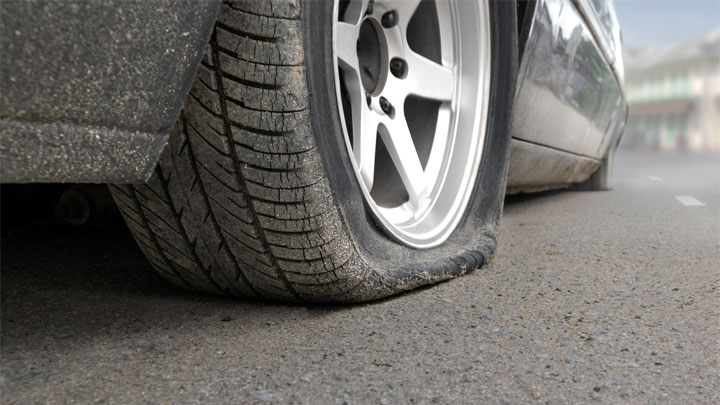
Read Also: 16 Best Tire Brands (Don’t Regret Your Purchase)
What Does a Flat Tire Feel Like When Driving?
A flat tire will feel a bit strange when you’re driving. By this, I mean your car might pull to the right or left when you’re accelerating or braking or just driving down the road normally. Or, you could hear a noise coming from one of the four corners of your vehicle that sounds like rhythmic slapping.
Since your car is meant to drive down the road with as much contact with the road as possible and you no longer have air in one tire, you will not be able to stop as quickly, turn, or maintain road contact during a storm.
This is even more reason to take a quick walk around your vehicle every time you want to drive, just to make sure nothing looks out of place. Anyone can do this, and I mean ANYONE!
It doesn’t matter if you think you don’t know anything about cars, just give yourself the agency to pick out something that just doesn’t look right. Trust your gut.
What To Do If You Get a Flat Tire
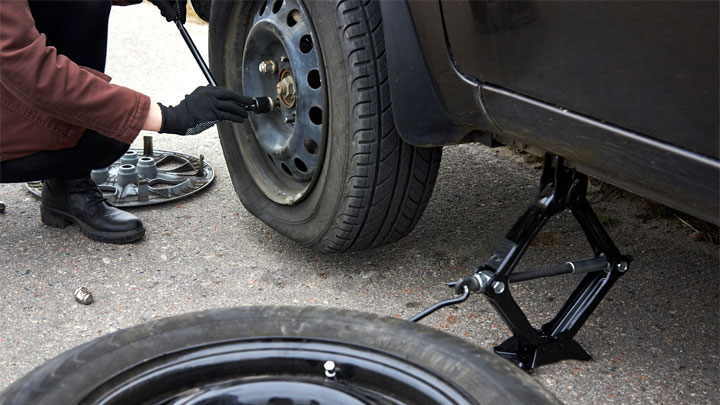
If you find you have a flat tire as you’re leaving the office, it’s time to get out that spare tire kit. This kit is usually located near your spare tire under a panel in the trunk, or to the right or left side of the inside of your trunk.
It’s usually secured in some way so it won’t rattle around in there, but it shouldn’t take much effort to pry away the jack, tire iron, and the jack “Spinner”, which you’ll need to generate enough leverage to move the jack up and down.
If you are standing there holding these tools, but honestly it’s stressing you out trying to figure out how to use them together, put them down. Take 3 deep breaths and think “Do I have a number I can call on the back of my insurance card?” (Chances are, you do).
Get out your wallet and, if it’s not in there, check the glovebox. It should be a little card no larger than a business card with the name of an insurance company on it. It’s worth mentioning that you should make sure that the insurance is valid, as you don’t want to get hit with unnecessary charges if you would only have to wait an hour or two for your friend to come help you.
If you get a flat tire while you’re driving down the road, you should first find a safe place to pull over. Then, when you’re sure it’s safe, go ahead and perform a visual inspection.
Is it low tire pressure, a slow leak, a complete blowout, or some other problem? If you don’t know how to identify these issues, scroll up to the top of this article and learn.
Related: How Long Can You Drive on a Spare Tire?
What Can Happen If You Continue to Drive on a Flat Tire?
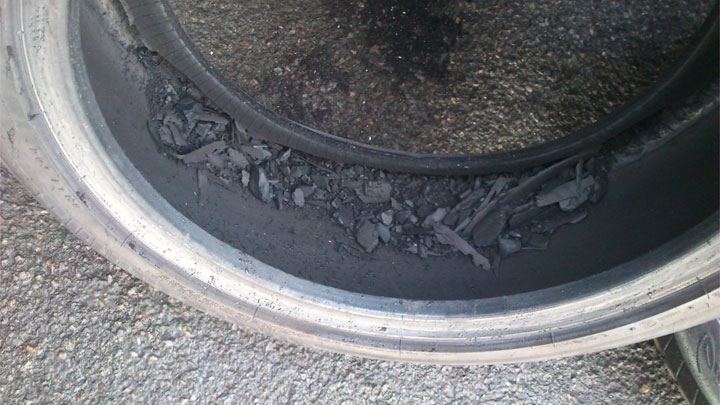
You should avoid driving on a flat tire AT ALL COSTS, and should only do this if you are getting to a safe location to perform a tire swap.
If you drive for too long on a flat tire, the rubber on the inside of the tire will start wearing away and chunks will even start coming off as the wheel rubs against it. This will then turn a simple flat tire repair into a tire replacement.
In addition, you will eventually start to eat away at the wheel, which is an expensive piece of kit. Not to mention you won’t have any traction on that corner of your car, which will result in an accident if you drive like you normally do.
Best practice is to slowly make your way to a safe location, perform a visual inspection, diagnose the issue, and get out your tire changing kit.
If you don’t have one of those or don’t feel comfortable, get out your insurance card from your glove box or wallet/purse and call the “Roadside Assistance” number on the back of that card.
How Far Can You Drive on a Flat Tire When There’s No Other Option?
Don’t drive on a flat tire if you can help it. The only time you should drive on a flat tire is if you just found out and you’re pulling off the road to a safe location to swap that tire out.
Think about it this way: your tire is like a spring that absorbs the impacts of debris, bumps, potholes, and other issues that are present on the roadway. If you remove all the air from the tire (when it’s flat), all of that energy from road issues will go straight into your rim and bend that metal.
If you bend this metal, your wheel is no longer round and you won’t be able to balance it properly at the local tire shop. The end result is that you’ll need to buy another wheel.
See Also: How Long Can You Drive With Low Tire Pressure Before It’s Dangerous?
Types of Flat Tires
While “flat tire” is kind of an umbrella term for almost any problem with your tire, there are a few different distinctions here that I feel are important to mention.
See Also: Low Tire Pressure Light On But Tires Are Fine? (What It Means)
#1 – Slightly Under-inflated
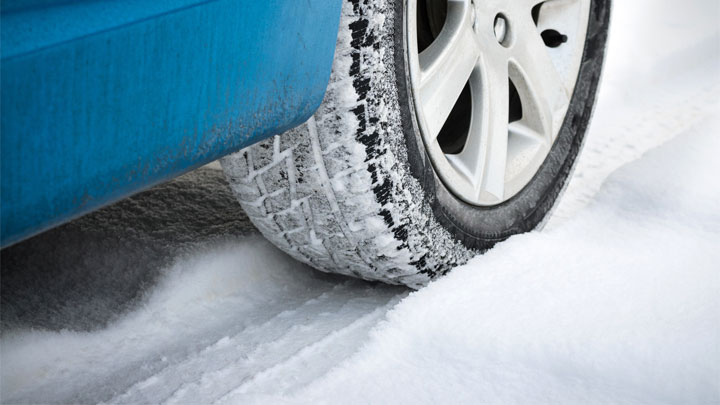
As the seasons change from spring to summer, fall to winter, so does the pressure of your tires. Why is that? Well, as temperatures decrease, there’s less outside influence on the air molecules inside of your tire so they won’t be moving around as much.
Without getting too much into the weeds, if those molecules aren’t moving around as quickly, they won’t put as much pressure on the side walls of the tire. So, as you round that bend into autumn, you might notice that your tire pressure has gotten a bit low (maybe a five PSI difference).
There are a few ways you can diagnose this issue visually without having any mechanical knowledge at all.
First, look down at the base of your tires and see if there’s a little portion that’s bowed out or distended at the bottom of the tire where it contacts the ground. If it’s looking a little flabby down there, you probably have low tire pressure and you should fill that baby up to the recommended factory specs.
Another way to diagnose this issue visually if you’re in a modern car is to scroll through the menu items on your dashboard or center console. Most cars will have a screen that tells you what the tire pressures are on your four tires. Even better, most cars will let you know with a tire pressure warning light in your instrument cluster that illuminates when you have low tire pressure.
Finally, if you notice that your fuel mileage has decreased drastically or even by one or 2 miles per gallon (on average) and there isn’t anything else wrong with your car, then your tire pressure should be checked.
#2 – Leaking
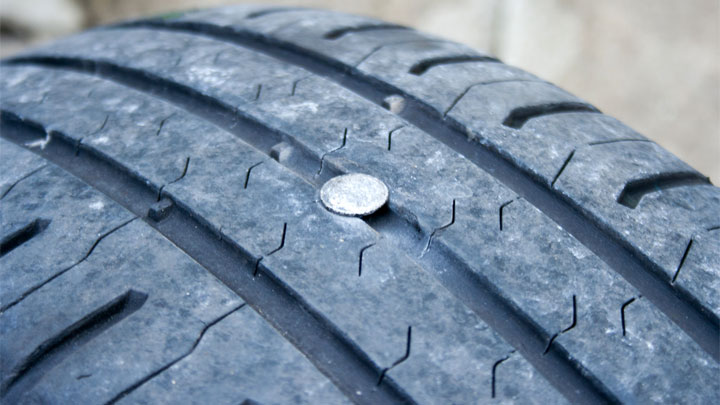
Another type of flat tire is called a “leaking tire“. This is when you have some sort of debris, nail, screw, pin, piece of glass, or other sharp object that’s lodged itself in your tread or in your tire that’s causing a slow leak.
When you get out of your car next time, use your ears and listen for any sort of small hissing sound. If you do hear a sound like this, you probably have a leaking tire. If you don’t hear anything, you still may have a small leak.
These types of leaks are sometimes very hard to diagnose because your car could lose one psi over a month or you may never even notice. However, if you find yourself constantly refilling your tires and you don’t know exactly why and they’re brand new, you might have a leaking tire.
See Also: DIY Repair and Maintenance? Why You Need a Good Floor Jack.
#3 – Completely Flat
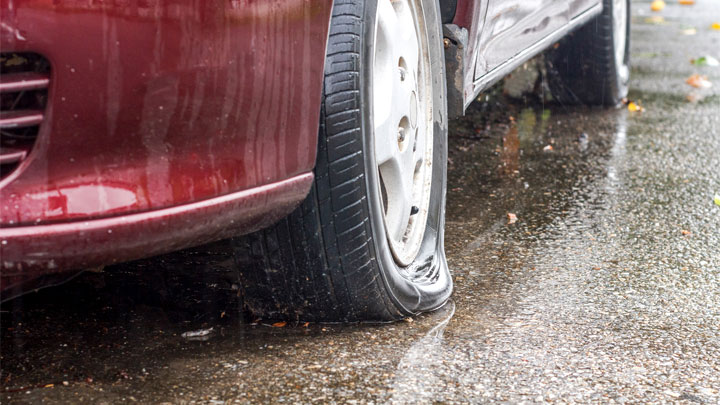
OK, say you leave the party at 1 AM and you get out to your car and one of the tires is completely flat, flabby, and the rim is resting on the ground. Get out your phone, turn on that light and take some pictures of your tire just in case there’s a vandalism problem here.
Now, more than likely this isn’t a vandalism issue and you probably just ran over a screw on your way to that party, but it never hurts to be safe in this case.
Examine the sidewall by running your fingers around the outside of the tire that’s facing you. Feel for any large markings or punctures that could indicate that someone has “slashed“ your tires.
If you don’t know how to change a tire, this would be the time to get out your insurance card and call AAA or whoever your car insurance provider allows for roadside assistance.
#4 – Blowout
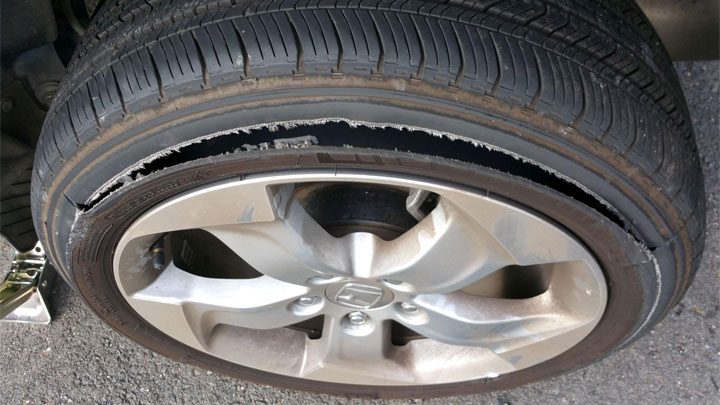
A blowout is the most dangerous type of flat tire. This normally happens when you’re moving down the road at a high rate of speed and then all of a sudden, you hear a pop and then arrhythmic “THWAPP THWAPP THUNK THUPUPUPUPUPU” as you’re moving down the highway.
This is a situation where you should immediately pull off to the side of the road and start getting out your tire changing kit or call AAA. It is also worth mentioning that most insurance companies have a roadside assistance program with the phone number on the back of your insurance card.
Upon visual inspection, you might notice that the tread isn’t connected to the sidewall anymore and there’s what looks like a large gash in your tire. Basically, it looks like a big problem with your tire.
You will still change this tire just like any other tire, you just may have to jack up the car a little bit higher so you can get enough lift on the rim because the tire will no longer be structural.
How to Prevent Getting a Flat Tire
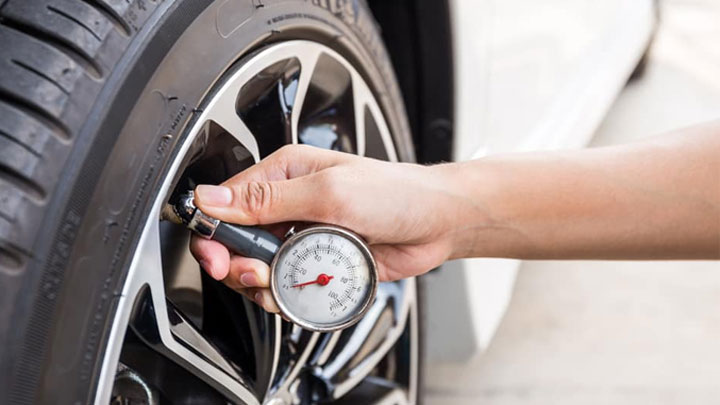
While this might seem like a question with an obvious answer, the simplest way to prevent getting a flat tire is to stop it before it happens.
Bear with me, but if you make a habit of checking your tires before each journey, not driving on the shoulder of the road or through construction sites regularly, and making sure to sweep up your workspace if you are doing woodwork in the driveway, you’ll avoid a lot of flat tires.
See Also: How to Prevent Dry Rot In Tires
On the other hand, you could use money and purchase these tires called “run-flat” which will allow you to travel almost 50 miles on a flat tire. This sounds great, but remember that they are heavier and more expensive than normal tires. Plus, you’ll need to replace the tire if it gets a flat, whereas it’s possible to plug/fix a normal tire.
Filling your tires with Nitrogen (Costco offers this free for members) has been proven to prevent some slow leaks but the actual benefits are still up for debate.
I think of tires as a “wear item”; something that is constantly wearing out. Just like checking your oil, coolant levels, blinker fluid, and the underside of your car for leaks, your tires deserve a loving look or two before going on an adventure.
- How Long Does Paint Protection Film Really Last? - Apr 23, 2024
- How to Reduce Wind Noise in Your Car (Locate the Source) - Nov 22, 2023
- How Long Can You Drive on a Spare Tire? (and How Fast Can You Go?) - Sep 13, 2023
